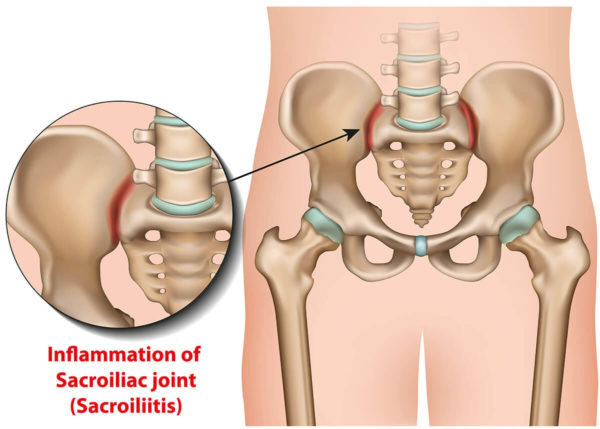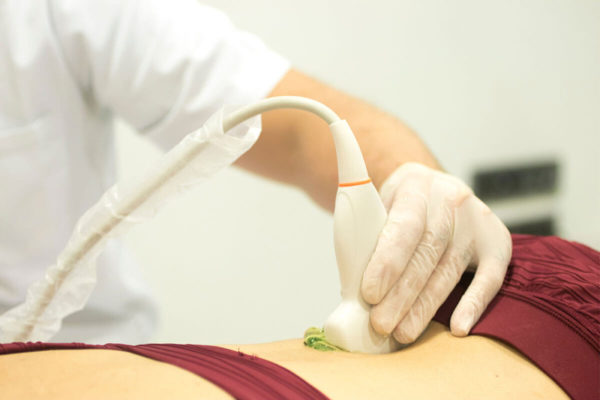What is sacroiliac joint pain?
The sacroiliac joint connects the lower back to the pelvis and is created by the ilium and the sacrum (2 bones which form part of the pelvis). There are two sacroiliac joints – one on the left and one on the right side. Sacroiliac joint pain effects both men and women of all ages but is most common in active females aged 20-40. It is also common in sports people, and pregnant women.
The sacroiliac joint is also susceptible to inflammatory conditions such as Ankylosing Spondylitis (AS). When the sacroiliac joint becomes inflamed it is known as sacroiliitis.
The symptoms of sacroiliac joint pain?
Symptoms of sacroiliac joint dysfunction:
- Pain in the lower back and buttock which can refer into the groin and leg
- Pain with prolonged standing, climbing stairs and rolling over in bed
- Pain over the lower back (located, in particular, under the dimples in your lower back)
Symptoms of sacroiliitis:
- Pain that wakes you at night
- Pain that is not improving with physiotherapy and rehabilitation
- Prolonged early morning stiffness and pain
What other conditions can present as sacroiliac joint pain?
If your symptoms do not match this then there are other conditions which can mimic the symptoms of sacroiliac joint pain such as:
- Piriformis syndrome
- Hip osteoarthritis
- Hip femoroacetabular impingement (FAI)
- Discogenic low back pain
- Lumbar facet joint pain
Sacroiliac joint pain vs hip osteoarthritis
Sacroiliac joint pain effects both men and women of all ages, but is most common in active females aged 20-40. It is also common in sportspeople, pregnant women and those with underlying inflammatory conditions such as Ankylosing Spondylitis (AS).
If you have these symptoms you may be experiencing sacroiliac joint pain?
Common symptoms:
- Pain in the lower back and buttock which can refer into the groin and leg
- Pain with prolonged standing, climbing stairs and rolling over in bed
Less common symptoms:
- Pain that wakes you at night
- Pain that is not improving and is particularly stiff and sore in the morning
- Tenderness when you touch your lower back (near the dimple on your back)
If this matches your symptoms please read on….
If this does not match your symptoms, there are other conditions which can mimic the symptoms of sacroiliac joint pain such as:
- Pain associated with the piriformis muscle
- Hip – osteoarthritis
- Hip – femoral acetabular impingement (FAI)
- Discogenic low back pain
- Lumbar facet joint pain
Anatomy of the sacroiliac joint?
The sacroiliac joint is the largest joint in the body and is a common cause of chronic low back pain. It has a somewhat atypical C shape connecting the spine with the pelvis bone. You have one joint on each side. As with other joints in the body, the sacroiliac joint and the surrounding ligaments can become damaged or inflamed. One condition associated with the sacroiliac joint that we see in the clinic, which can be a very painful condition is known as sacroiliitis (see image below).

Sacroiliitis can be a difficult injury to diagnose and is often an overlooked diagnosis when patients are presenting with lower back and/or buttock pain. It can cause significant pain and disability for an extended period of time. On occasions an injection is required to settle down the inflammation in the joint, particularly if anti-inflammatory medication have not resolved the pain. Sacroiliitis is also associated with other systematic inflammatory conditions such as Ankylosing Spondylitis (AS). If you have been diagnosed with sacrolilitis you must be screened by a doctor to rule out any of these conditions.
Sacroiliac versus sacroiliitis
Sacroiliac joint pain occurs due to:
- Sacroiliac joint dysfunction
- Sacroiliitis
These terms are often used interchangeably as the pain arises from the same joint but they are different. In the article we refer to both conditions.
Sacroiliac joint dysfunction – is caused by abnormal mechanics between the two sides of the pelvis (known as the ilium). There may be too much movement on one side or too little. The asymmetry causes increase stress and shearing forces on one side, which can lead to irritation of the joint and pain.
Sacroiliitis – is classified as an inflammation of the joint. An ‘itis’ indicates inflammation. This can occur due to sacroiliac joint dysfunction or secondary and part of an systemic inflammatory condition (more later). Sacroiliitis often causes constant pain and worse at night with associated pain and stiffness in the morning.
What are the symptoms of typical sacroiliac joint pain?
The classic signs and symptoms of sacroiliac pain are:
- Pain located in the lower back (specifically near the dimple of your back) into the buttocks and occasionally into the leg and foot. It can be on both sides but is more common on one side. The pain is most commonly located just above the buttocks and below the lower back (see image below).
- Pain worse at night and significantly worse pain and stiffness in the morning (for > 30 minutes). Often patients will wake at night and find it difficult to get comfortable.
- Pain associated with twisting and turning e.g., rolling over in bed or getting in and out of the car.
- Prolonged standing, walking and climbing stairs often aggravate the pain

What causes typical sacroiliac joint pain?
Most cases of sacroiliac joint pain are not related to underlying conditions and are caused by:
- poor posture and stiff joints
- asymmetrical activity such as crossing your legs
- altered leg mechanics e.g., a significant leg length discrepancy (most of us have a slight discrepancy, which is normal).
- muscles imbalances
Your clinician will be able to assess for these contributing factors at your initial assessment.
Other causes include:
- Systemic inflammatory diseases such as Ankylosing Spondylitis (AS), psoriatic arthritis, and reactive arthritis, among others are associated with sacroiliitis. Sacroiliitis is often found as a symptom of an inflammatory conditions of the spinal column. As a group, these conditions are termed a “spondyloarthropathy”. Sacroiliitis may also be a component of other types of arthritis, such as ulcerative colitis and Crohn’s disease. If you have been diagnosed with sacroiliitis or have been diagnosed with a one of these conditions or diseases and are experiencing back pain, you should consult with you GP.
- Pregnancy – due to the change’s pregnancy places on your ligaments and joints to accommodate your foetus and in preparation for child birth. The additional weight and your altered biomechanics and gait during pregnancy can cause additional stress on your joints and cause pain. The sacroiliac joint is a common area of pain during pregnancy.
If you do have pain related to your pregnancy, we recommend you see one of our Complete Women’s Health team, who specialise in pre- and post-natal pain.
- Trauma – sacroiliac joint pain can be caused by a fall such as falling off a horse, whilst skiing or even tripping up a curb i.e., ‘missing a step’.
- Infection – this is a rare cause of sacroiliitis. However, if you have another infection in your body at the same time as the back pain, this it must be considered and ruled out. If you are feeling unwell, have a temperature and feel tired all the time then you should see your GP immediately.

How do we diagnose sacroiliac joint pain (also known as sacroiliitis)?
Clinical examination which includes a series of orthopaedic and motion tests aswell as specific palpation of the joint and surrounding ligaments will indicate if the source of the pain is the sacroiliac joint. Further imaging tests will confirm if the source of the pain is the sacroiliac joint. X-ray and MRI scans will show changes of inflammation and degeneration. Sacroiliitis will be diagnosed with an MRI scan.
It can be difficult to recognise sacroiliac joint pain from other causes of low back pain. It has been documented that sacroiliac joint pain makes up 10-30% of all causes of chronic low back pain. Remember, pain from the sacroiliac joint may cause buttock pain and often moves to the low back, groin, hip, or leg. This is similar to other sources of back pain.
It is not an understatement to say that the diagnosis of sacroiliac joint pain is challenging for many practitioners, but a clear diagnosis is essential for optimal management. At Complete we believe that a timely diagnosis is essential for ensuring you get the right treatment at the right time, to avoid prolonged, unnecessary pain.
How do we treat sacroiliac joint pain?
Most cases of sacroiliac pain and sacroiliitis will improve with medication, relative rest, modification of activity and physiotherapy. Anti-inflammatory medication can be useful to help you manage your pain and allow you to engage in your rehabilitation.

In difficult cases that fail to respond to physiotherapy, particularly those that have been diagnosed on imaging as sacroiliitis, may require an injection to help relieve the pain.
Most clinicians use cortisone (steroid) injections, although platelet-rich plasma (PRP) injections are becoming more popular. A recent study showed that injections in the sacroiliac joint were effective in 80% of the cases and the effect lasted for an average of 8 months.
How do we perform a sacroiliac joint injection?
Due to the complex anatomy of the joint, all sacroiliac joint injections should be performed under imaging guidance. Without imaging the injections often miss the joint (poor accuracy) and are less effective.
Traditionally, these injections were done under X-ray (fluoroscopy) with a dye, a procedure known as fluoroscopy. While X-ray guided injections are accurate, there are many concerns with this type of injection including exposure to radiation, the need for a dye, and the expense of needing a surgical room and a few helpers.

Diagnostic ultrasound is a useful tool to guide musculoskeletal injections due to less cost and no exposure to radiation. However, we have always believed that ultrasound is less accurate than X-ray because of the difficult anatomy of the sacroiliac joint. However, recent studies argue against this view. One study showed that accuracy and effectiveness were equal in ultrasound and X-ray-guided SI joint injections. Another recent study found that ultrasound-guided sacroiliac joint injections had equal accuracy and effectiveness to X-ray-guided injections in patients with sacroiliac joint arthritis. In summary, it would seem that ultrasound is as good as X-ray in guiding sacroiliac injections with the added benefit of being less cost and no exposure to radiation.
Can we use PRP for a sacroiliac joint injection?
Recent evidence suggests that PRP or platelet-rich plasma is effective for some types of arthritis such as knee arthritis. While some practitioners support the use of PRP for a sacroiliac joint injection, the evidence for effectiveness is low. Nonetheless, there are a few studies that have shown a good response to injecting PRP into sacroiliac joints. PRP injections should only be considered in cases that fail exercise therapy and one or two guided cortisone injections.
In summary, sacroiliac joint pain is a common cause of chronic low back or buttock pain. This pain is common in sportspeople, during pregnancy, and after an injury. Treatment consists of physiotherapy supplemented by injections. Traditionally, an X-ray guided sacroiliac joint injection is used to guide the needle into the joint. More recently, ultrasound can guide correct needle placement and involve less cost and no radiation.
Dr Lorenzo Masci (www.sportdoctorlondon.com) is a consultant in Sports and Exercise Medicine with expertise in ultrasound-guided injections. He performs sacroiliac and peripheral joint injections under ultrasound at Complete Physio (Chelsea location).
To book, please contact info@complete-physio.co.uk or call 020 7482 3875

